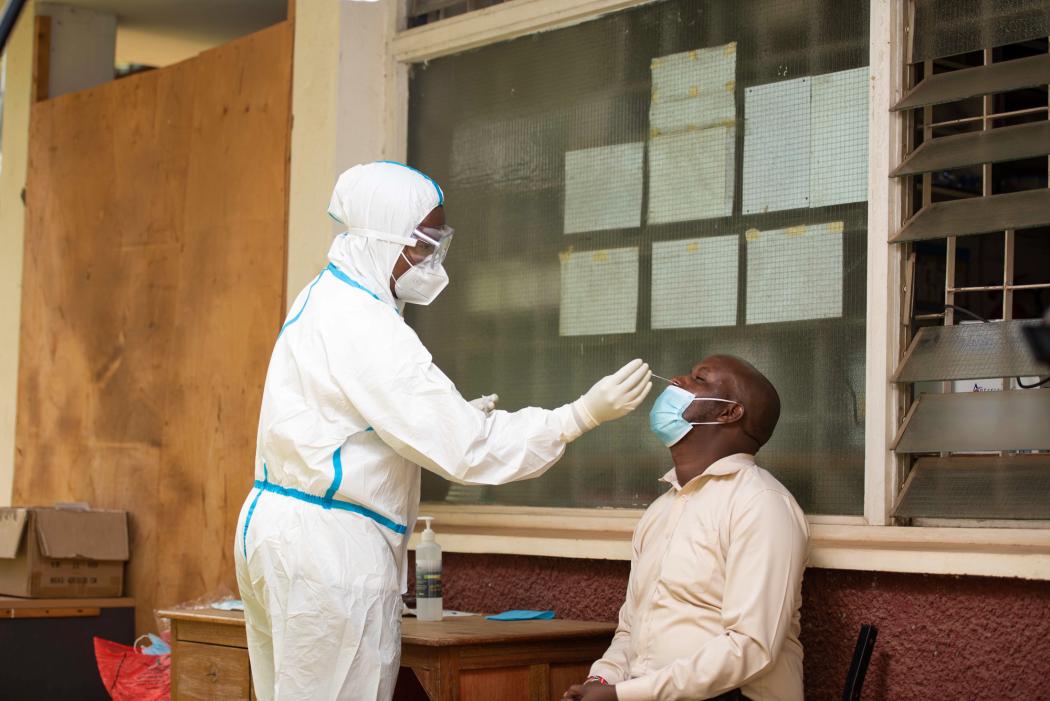The Global Health Workforce Should Be at the Center of New White House Initiative

Babito, a medical lab technologist at Westlands Medical Center in Kenya, takes COVID-19 patient samples and stores them before they are taken to the lab for testing. Phot by Edwin Joe for IntraHealth International.
As the White House considers launching a new initiative to strengthen the global health workforce around the world, I sat down with Janet Muriuki, a doctor and health workforce expert from Kenya who serves as IntraHealth International’s interim director of health workforce development and Kenya country director.
We talked about what she thinks the Biden Administration needs to consider in order to help build a strong and sustainable health workforce in Africa.
DB: How could this new White House initiative lead to more high-quality health care in Africa?
JM: To improve quality of care in Africa and beyond, the US initiative should focus on three things:
- Health workers must be trained adequately to implement high-quality services and include quality improvement and management approaches to address bottlenecks and challenges I have seen partners come in and do ad hoc quality improvement for teams at health facilities, but is there a reporting structure upwards to the national level? Quality management units need to be set up at the sub national level with dedicated focal persons to link facility quality improvement teams to the national quality management department at the Ministry of Health.
- The initiative has to focus on compensation and answer questions like:
- Are you paying at government rates?
- If the pay is poor, how is that country also motivating its health workers with non-financial incentives? What does the appraisal system look like?
- What's the work environment like for health workers?
These issues determine whether health workers are engaged or if they're absent either mentally or physically.
- And then the work environment also matters. Countries must provide health workers with the right tools and an infrastructure that supports them in making the correct diagnostic decisions.
DB: How can the US do a better job of supporting the health workforce?
JM: The US initiative must work with governments.
For instance, PEPFAR- and US government-funded projects have their own peer counselors, adherence counselors, mentor mothers, mosquito catchers, and other lay cadres of health workers. But some of these cadres are outside the government scheme of service and they duplicate what community health workers are already doing or could do.
Why not invest in community health workers and ensure they are trained, paid, and recognized by the government?
Instead of creating these parallel cadres, why not invest in community health workers and ensure they are trained adequately, are paid, and are recognized under government schemes of service?
DB: How should a US global health workforce initiative measure progress?
JM: By using generalized workforce indicators that don’t just focus on one disease or service component.
Historically, PEPFAR (President’s Emergency Plan for AIDS Relief) indicators haven’t looked at systems. They tend to be centered on HIV rather than on a broad spectrum of services. Under this new White House initiative, I suggest incorporating gender, workplace protection measures, and total workforce indicators, and then looking at how they're distributed to support various service components.
We also must ask if the measures of progress are balanced and in line with the country's norms and standards—and not simply assess if the country has reached the WHO target ratio for workforce by population. Systems take time to build, so the initiative should also consider the milestones and progression every three, five, and ten years.
DB: Do you think a White House initiative would lead countries in the region to invest more in the health workforce?
JM: Yes, I think there is interest in doing more for health workers.
For example, we have seen governments in East Africa become more interested in human resource information systems. I think resources from a partner like the US could support governments to fully embrace a health information system. That way the US is not paying health workers’ salaries but providing them with a system that can be used to generate data for informed decision-making.
And I would say health systems strengthening components should get the same resources as most service delivery components. Service delivery cannot be taking the lion’s share of the resources, since it is actually the health system and workforce that makes it possible to reach health targets. They are synergetic.
DB: Do you see some ways the US could influence the Global Fund or other mechanisms to better support the workforce?
JM: Yes. I think the US should influence them quite a bit.
In our experience experts in the health workforce are brought into the Global Fund processes only as an afterthought. I think experts on health systems strengthening at the country level need to be at the table at the beginning of grant proposal discussions, especially for human resources for health.
Many aspects in the implementation of Global Fund resources really touch on the health worker and Global Fund planning has to consider the workload and distribution of health workers to meet their communities’ needs.
This post was originally published on IntraHealth's VITAL blog.
